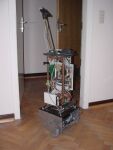Overview

The RoboGuard [1][3] is a very early example of the development of a mobile security robot from the late 1990’s. , i.e., an autonomous robot The goal of the RoboGuard project was to develop a commercial monitoring and surveillance robot for warehouses and other storage facilities. The control and autonomous functions of the device was based on the RoboCube hardware [5] and behavior-based software [2][4]. The project started with support from the Flemish Action Program for Information Technology in 1998 and it ran until 2001.
The RoboGuard supported remote monitoring and patrolling through a mobile platform using onboard cameras and sensors. The development of the robot hardware and its software was conducted at the Artificial Intelligence Laboratory (AI-lab) of the Vrije Universiteit Brussel (VUB) under Andreas Birk as principal investigator. CCTV systems at the time were both costly and caused many false alarms due to limited video quality. The Interuniversity Microelectronics Centre (IMEC) as project partner hence investigated wavelet-based compression of digital video. The company Periphere, later renamed to Quadrox provided as third project partner expertise related to video surveillance and the commercialization of related products.
Three different prototype versions of the RoboGuard were developed during the project using among others the CubeSystem. Lessons learned from the development of the RoboGuard were later on useful for the development of other mobile robots for Safety, Security, and Rescue Robotics at Constructor University, e.g., papa & mother goose and the goslings and the ruggedbot design.
While there were promising prototypes, there were multiple factors why the device never became a commercial product in the end. First and foremost, this surveillance robot was intended to be an alternative to CCTV systems. But at the time, IP-based security cameras emerged, which simply provided a very cost-effective alternative, especially with respect to installation, as Ethernet cabling became omni-present even in warehouses. WiFi data transmission that the mobile robot required to transmit video or at least images was still low-bandwidth and costly at the time. A second important factor was “new economy” crash – also known as the burst of the dot-com bubble – in 2001, which led to a significant down-turn in IT-related technology investments.
Publications
You can get the publications related to the RoboGuard by clicking on [Open Access PDF], respectively click on [Preprint PDF] to get a preprint copy via ResearchGate:
[1] A. Birk and H. Kenn, “RoboGuard, a Teleoperated Mobile Security Robot,” in Telematics Applications in Automation and Robotics, Elsevier Science, 2001. [Open Access PDF]
[2] A. Birk and H. Kenn, “An Industrial Application of Behavior-Oriented Robotics,” in Proceedings of the International Conference on Robotics and Automation (ICRA), 2001. https://doi.org/10.1109/ROBOT.2001.932640 [Preprint PDF]
[3] A. Birk and H. Kenn, “RoboGuard, a Teleoperated Mobile Security Robot,” Control Engineering Practice, vol. 10, pp. 1259-1264, 2002. https://doi.org/10.1016/S0967-0661(02)00088-6 [Preprint PDF]
[4] A. Birk, H. Kenn, and L. Steels, “Programming with Behavior Processes,” International Journal of Robotics and Autonomous Systems, vol. 39, pp. 115–127, 2002. https://doi.org/10.1016/S0921-8890(02)00198-7 [Preprint PDF]
[5] A. Birk, “Fast Robot Prototyping with the CubeSystem,” in International Conference on Robotics and Automation (ICRA), 2004. https://doi.org/10.1109/ROBOT.2004.1302539 [Preprint PDF]